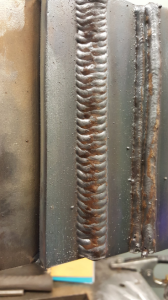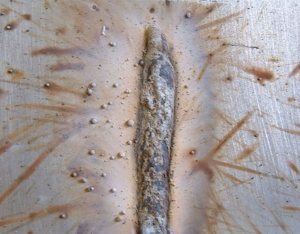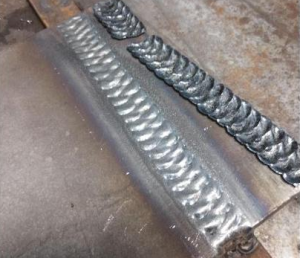Gasless MIG welding can achieve weld strengths up to 65,000 psi, making it robust for outdoor and structural applications.
Comparative Strength of Gasless vs. Gas MIG Welding
Gasless MIG welding, usually with a flux core, and traditional gas MIG welding using shielding gas are significantly different in performance and application. The primarily different issue is their working environments and the strength of the welds they yield.
Gas MIG welding generally displays cleaner and stronger work when used in controlled environments. The gas – usually argon, carbon dioxide, or a mixture thereof protects the weld from the atmosphere, which allows for a more consistent bead with fewer impurities. An accomplished welder might achieve a tensile strength of up to 70,000 psi on mild steel using these gases.
On the other hand, gasless welding typically performs better in the outdoors or when the wind makes gas welding impractical. The flux core used in these welders burns and generates its own shield gas, which protects the weld but makes the finish a bit rougher and, at times, requiring more cleanup. The tensile strength of gasless welds on similar materials usually varies around 65,000 psi, a bit less than gas welding.
The deciding factor for most small-time and hobby welders will be the cost. Gasless, as the name implies, require much fewer acquisitions, getting rid of the expensive gas cylinders and complex performers used in MIG welding. The cost can be a whole lot cheaper for a single weld, up to 20-30% on average. The performance to time ratio in gas MIG welding is better than in gasless welding, allowing welders to work faster, as the gas assures a sound working environment at high speed. Time might even become more important than the quality of the weld in high production. Gas welds also typically display greater longevity and corrosion resistance because of the cleaner environment created during welding. The strength and finish of the welds made with the gasses make MIG welding ideal for permanent applications that demand quality, such as long-term structures or automotive frame assembly .

Optimal Settings for Gasless MIG Welding Machines
It’s very important to properly set up a gasless MIG welding machine in order to achieve strong and reliable welds. The main variables a person adjusts on a gasless MIG welder are voltage and wire feed speed, which significantly affect the quality and the strength of the weld. An incorrect wire feed speed might cause a finished product to have too little or too much filler, while the incorrect voltage might either cause insufficient penetration or burn-through.
Selecting the right voltage is the key to penetrating the material properly. For thinner materials, it’s necessary to set the machine on lower voltage settings to prevent burn-through on the other side. For a material that’s roughly 1/8th of an inch thick, a person should adjust the voltage between 18 and 22 volts. However, as the thickness of the material fluctuates, the volts should be set higher if the material is thicker, which is needed for greater penetration.
Wire feed speed is also crucial to the quality of a weld. A higher wire feed speed results in a wider and more massive weld bead on the finished product. In the case of very thick materials, it’s desirable to produce a wider weld bead. However, generally, a wire feed speed setting of 250 to 400 inches is considered to be the most effective one. It’s stable for the majority of projects and welds and combines the parameters a person should consider – making the weld quality high while still being effective.
An ideal balance of high voltage and wire feed speed affects productivity greatly. Thanks to this balance, a welder can work faster without affecting the quality of an operation. Incorrect settings might result in problems such as spatter, poor penetration, or a ‘cold lap’, which is a weld that is so weak it just breaks when an object is mechanically pushed. A properly tuned machine creates welds that are sturdier and can endure greater stress. These welds also endure other mechanical stresses and environmental factors better, providing a longer lifespan for the joint. Such settings also save on material use and electricity use.
Performance of Gasless MIG Welds Under Stress
When considering that gasless MIG welding is used in structural applications, it is imperative to ensure that these welds can resist the stress to which they are subjected. This involves loading them in various ways such as in tension, compression, and shear, and allowing to determine the strength of the weld. In terms of tensile strength, it is difficult to break the gasless MIG welds when exposed to significant stress. For example, when loading a 1018 mild steel plate, extricating 65,000 psi safely is enough for most construction jobs. Similarly, the application of these materials has convinced engineers that the load of 65,000 psi is needed to ensure the long-term structural integrity of these types of welding.
Another crucial factor to consider is the shear strength of the welding, as some materials are usually forced to slide relative to others in their joints. Such areas should be designed with the intention of integrating a shearing area, as joint resistance in this area is responsible for ensuring the safety of lives in various industries. For example, parts produced by gasless MIG welding on an aluminum material often develop a shearing strength of 25,000 psi. However, the low performance of such welding materials is not among the considerations for the design of planes and cars when placed in service.
Surprisingly, gasless MIG welding has Little performance in industrial setting environments, as can be supported since it is improved by elements such as moisture and dust and thus, heat production is necessary. Similarly, the overall cost of design is reduced by not letting it interfere with the work, as shielding gases flow freely throughout the atmosphere. Similarly, gas MIG has the lowest productivity at marine temperatures and thus should best be kept metallic architecture production plants. The above operations support the high rates of time and cost savings up to a third of the cost at every scale of work.
Troubleshooting Common Issues in Gasless MIG Welding
Gasless MIG welding imposes several problems and difficulties, especially related to the weld’s quality. However, their successful solution can improve the quality of welding and facilitate the welding process itself. Spatter is one of the most common issues in this case, referring to excessive burning of the contact tip and deposition of small molten metal drops all over. It leads to a lack of cleanliness and neatness of the welding and is usually caused by setting a voltage that is either too high or too low, as well as too high wire feed speed. Reducing the effect of spatter requires the reduction of the voltage or modification of the wire feed speed. For instance, high spatter might be affected by the 20 volts setting when a lower, around 18 volts, is set instead, and the wire speed is adjusted, in this case, from 300 to 280 inches per minute, consequently leading to a much cleaner weld. Another main issue is too little penetration during the weld, causing weak joints that may break due to overload. At the same time, it might be caused by poor voltage setting that is too low, and the wire feed is too fast. Therefore, to increase penetration, the voltage must be raised or the feed speed reduced. On 1\3 or 1\4 steel, the voltage can be set around 22 or 24 volts and the same with wire feed to match the material thickness.
Another issue that is less connected with the weld itself yet still disrupts the welding process is related to proper feeding of the wire. Several interruptions connected with improper setting of the wire feeder tension and the drive roll’s wear condition cause various entangling of the wire. Maintenance check and the timely replacement of the roll, around every 100 hours of welding, can help fight these problems. Finally, another problem at the beginning of the weld is getting it stuck, and application of another technique, such as a slight weld before its full start, can help prevent sticking for a better initial weld.





